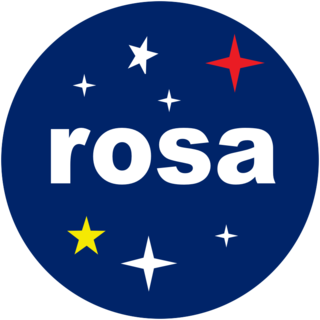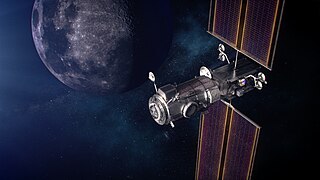Related Research Articles

An aerobot is an aerial robot, usually used in the context of an unmanned space probe or unmanned aerial vehicle.

Geoffrey Alan Landis is an American aerospace engineer and author, working for the National Aeronautics and Space Administration (NASA) on planetary exploration, interstellar propulsion, solar power and photovoltaics. He holds nine patents, primarily in the field of improvements to solar cells and photovoltaic devices and has given presentations and commentary on the possibilities for interstellar travel and construction of bases on the Moon, Mars, and Venus.

Shuttle-derived vehicles (SDV) are space launch vehicles and spacecraft that use components, technology, and infrastructure originally developed for the Space Shuttle program.

Charles Elachi is a Lebanese-American professor (emeritus) of electrical engineering and planetary science at the California Institute of Technology (Caltech). From 2001 to 2016 he was the 8th director of the Jet Propulsion Laboratory and vice president of Caltech.

The NASA Institute for Advanced Concepts (NIAC) is a NASA program for development of far reaching, long term advanced concepts by "creating breakthroughs, radically better or entirely new aerospace concepts". The program operated under the name NASA Institute for Advanced Concepts from 1998 until 2007, and was reestablished in 2011 under the name NASA Innovative Advanced Concepts and continues to the present. The NIAC program funds work on revolutionary aeronautics and space concepts that can dramatically impact how NASA develops and conducts its missions.
The International Academy of Astronautics (IAA) is an independent Paris-based non-governmental organization that was founded in Stockholm (Sweden) on August 16, 1960, by Dr. Theodore von Kármán. It received recognition from the United Nations in 1996.

Space-based solar power is the concept of collecting solar power in outer space with solar power satellites (SPS) and distributing it to Earth. Its advantages include a higher collection of energy due to the lack of reflection and absorption by the atmosphere, the possibility of very little night, and a better ability to orient to face the Sun. Space-based solar power systems convert sunlight to some other form of energy which can be transmitted through the atmosphere to receivers on the Earth's surface.
The Space Solar Power Exploratory Research and Technology program (SERT) program, conducted by NASA, was initiated by John C. Mankins and led by Joe Howell in March 1999 for the following purpose:

The Romanian Space Agency is a public institution with extra-budgetary funding that coordinates Romania's national space technology research programs and space research-related activities. ROSA was founded in 1991 and is subordinate to the Ministry of Education.
Jerome Pearson was an American engineer and space scientist best known for his work on space elevators, including a lunar space elevator. He was president of STAR, Inc., and has developed aircraft and spacecraft technology for the United States Air Force, DARPA, and NASA. He held several patents and was the author of nearly 100 publications in aircraft, spacecraft, electrodynamic tethers, SETI, and global climate control.

Non-rocket spacelaunch refers to theoretical concepts for launch into space where much of the speed and altitude needed to achieve orbit is provided by a propulsion technique that is not subject to the limits of the rocket equation. Although all space launches to date have been rockets, a number of alternatives to rockets have been proposed. In some systems, such as a combination launch system, skyhook, rocket sled launch, rockoon, or air launch, a portion of the total delta-v may be provided, either directly or indirectly, by using rocket propulsion.

The National Aeronautics and Space Administration is an independent agency of the U.S. federal government responsible for the civil space program, aeronautics research, and space research. Established in 1958, NASA succeeded the National Advisory Committee for Aeronautics (NACA) to give the U.S. space development effort a distinctly civilian orientation, emphasizing peaceful applications in space science. NASA has since led most American space exploration, including Project Mercury, Project Gemini, the 1968–1972 Apollo Moon landing missions, the Skylab space station, and the Space Shuttle. NASA currently supports the International Space Station and oversees the development of the Orion spacecraft and the Space Launch System for the crewed lunar Artemis program, the Commercial Crew spacecraft, and the planned Lunar Gateway space station.

Deep space exploration is the branch of astronomy, astronautics and space technology that is involved with exploring the distant regions of outer space. However, there is little consensus on the meaning of "distant" regions. In some contexts, it is used to refer to interstellar space. The International Telecommunication Union defines "deep space" to start at a distance of 2 million km from the Earth's surface. NASA's Deep Space Network has variously used criteria of 16,000 to 32,000 km from Earth. Physical exploration of space is conducted both by human spaceflights and by robotic spacecraft.

Stamatios (Tom) M. Krimizis is a Greek-American scientist in space exploration. He has contributed to many of the United States' unmanned space exploration programs of the Solar System and beyond. He has contributed to exploration missions to almost every planet of the Solar System. In 1999, the International Astronomical Union named the asteroid 8323 Krimigis in his honor.

Robert David Braun is an American aerospace engineer and academic. He has served as the dean of the College of Engineering and Applied Science at the University of Colorado Boulder, the David and Andrew Lewis Professor of Space Technology at the Georgia Institute of Technology, and the NASA Chief Technologist. Currently, Dr. Braun is the Space Sector Head at the Johns Hopkins University Applied Physics Laboratory (APL).

David A. Spencer is the Mars Sample Return Campaign Mission Manager at the Jet Propulsion Laboratory. As an aerospace engineer, Spencer designs and operates planetary spacecraft.

Technology readiness levels (TRLs) are a method for estimating the maturity of technologies during the acquisition phase of a program. TRLs enable consistent and uniform discussions of technical maturity across different types of technology. TRL is determined during a technology readiness assessment (TRA) that examines program concepts, technology requirements, and demonstrated technology capabilities. TRLs are based on a scale from 1 to 9 with 9 being the most mature technology.
The World Is Not Enough (WINE) is a US project developing a refuelable steam engine system for spacecraft propulsion. WINE developed a method of extracting volatiles from ice, ice-rich regolith, and hydrated soils and uses it as steam propulsion which allows the spacecraft to refuel multiple times and have an extraordinary long service lifetime. This would allow a single spacecraft to visit multiple asteroids, comets or several landing locations at an icy world such as the Moon, Mars, Pluto, Enceladus, Ganymede, Europa, etc.

The Power and Propulsion Element (PPE), previously known as the Asteroid Redirect Vehicle propulsion system, is a planned solar electric ion propulsion module being developed by Maxar Technologies for NASA. It is one of the major components of the Gateway. The PPE will allow access to the entire lunar surface and a wide range of lunar orbits and double as a space tug for visiting craft.

The Habitation and Logistics Outpost (HALO), also called the Minimal Habitation Module (MHM) and formerly known as the Utilization Module, is a scaled-down habitation module as part of the Lunar Gateway. It will be built by Northrop Grumman Innovation Systems. A single Falcon Heavy will launch HALO along with the PPE module and Halo Lunar Communication System, no earlier than November 2025.
References
- ↑ Dance, Amber (16 September 2008). "Beaming energy from space". Nature. doi:10.1038/news.2008.1109 . Retrieved 22 November 2018.
- 1 2 John Mankins Biography, National Space Society.
- 1 2 "About us", Artemis Innovation web page
- ↑ Rumerman, Judith A. (2009) Figure 2-5, NASA Historical Data Book, Vol. VII Scientific and Technical Information Division, National Aeronautics and Space Administration, NASA SP-2009-4012, ISBN 978-0-16-080501-1
- ↑ Dr. John Mankins, The Space Show
- ↑ Fenton, M., and Wood, J., eds. (2003), "Administrator's corner", NASA Vision, Vol. 1, No. 4, July.
- ↑ Mankins, J. C., "Time for a Change," NASA HQ Memo. Posted to SpaceRef.com: "John Mankins Departs NASA", September 23, 2005.
- ↑ Mankins, John C. "A Fresh Look at Space Solar Power: New Architectures, Concepts and Technologies" (PDF). National Space Society . Retrieved November 28, 2018.
- ↑ National Space Society, Statement of John C. Mankins Archived 2014-04-19 at the Wayback Machine U.S. House Subcommittee on Space and Aeronautics Committee on Science, Sep 7, 2000
- ↑ Mankins, John; Kaya, Nobuyuki (eds.) (2011). The First International Assessment Of Space Solar Power : Opportunities, Issues And Potential Pathways Forward. International Academy of Astronautics. p. 249.
{{cite book}}:|first2=has generic name (help) - ↑ "How Japan Plans to Build an Orbital Solar Farm". 2014-04-24. Retrieved 22 November 2018.
- ↑ Mankins, John (2014). The Case for Space Solar Power. Virginia Edition Publishing. p. 488. ISBN 978-0-9913370-0-2.
- ↑ Mihaly, Heder (September 2017). "From NASA to EU: the evolution of the TRL scale in Public Sector Innovation" (PDF). The Innovation Journal. 22: 1–23. Archived from the original (PDF) on October 11, 2017.
- ↑ Mankins, J. C. (2009), "Technology readiness assessments: A retrospective", Acta Astronautica, 65, No. 9-10, pp. 1216–1223, Pergamon
- ↑ Mankins, J. 1995, Technology Readiness Levels—A White Paper. Washington, DC, USA: Advanced Concepts Office, Office of Space Access and Technology, National Aeronautics and Space Administration (NASA).